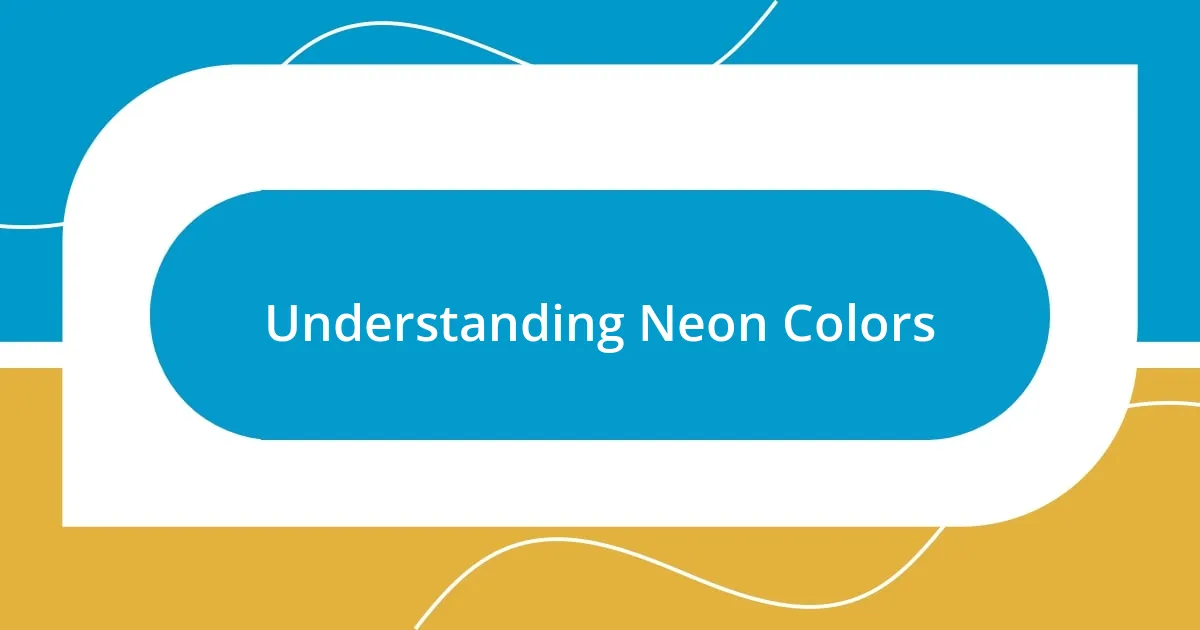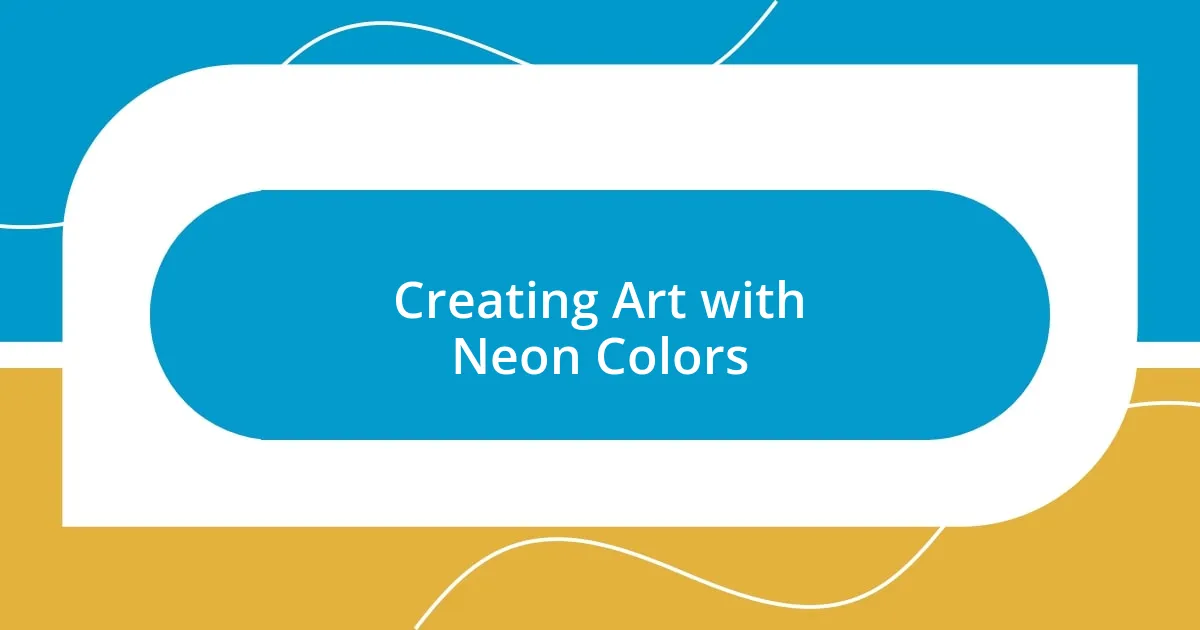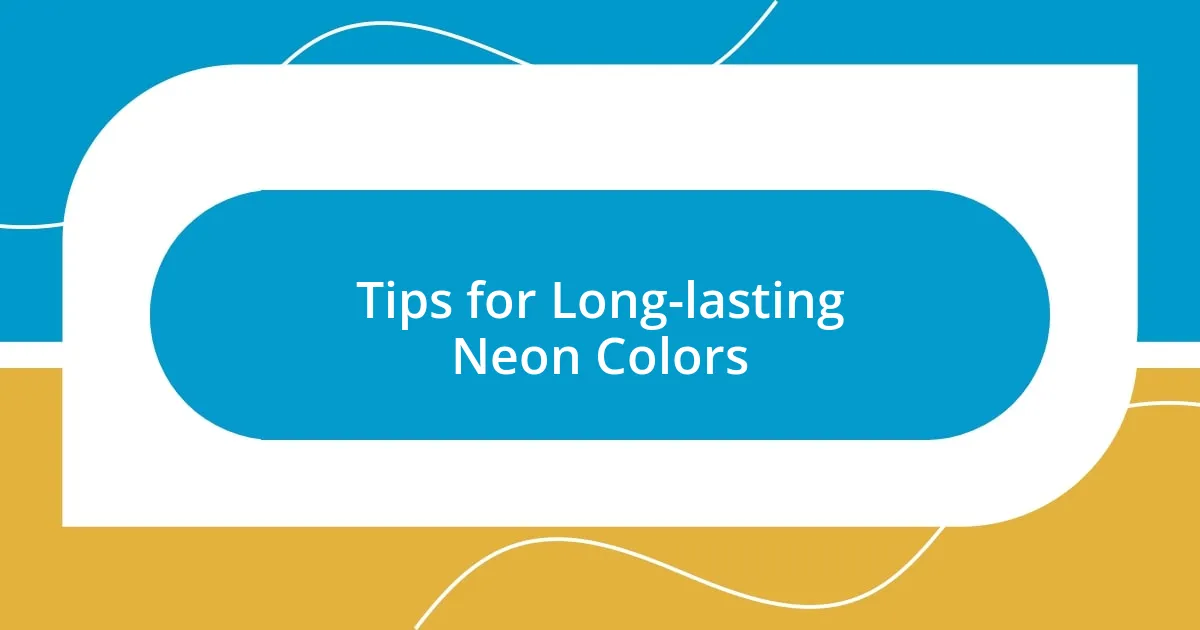Key takeaways:
- Neon colors are high visibility hues that evoke strong emotional responses and can transform the atmosphere of a space or artwork.
- Selecting the right neon colors involves considering the intended emotional effect and experimenting with color combinations for contrast.
- Blending neon colors requires techniques like layering and glazing to achieve harmonious transitions without overpowering vibrancy.
- Displaying neon art effectively relies on background choice and lighting to enhance the glowing impact of the colors.

Understanding Neon Colors
Neon colors are fascinating and vibrant, often evoking a sense of nostalgia for me. I vividly remember the first time I walked into an art supply store and saw those bright hues. They practically jumped off the shelves, and I couldn’t resist picking up a few tubes. Have you ever felt that rush of excitement when colors seem to speak to you?
These colors are distinct due to their high visibility and intensity, making them perfect for catching attention. I’ve noticed how neon colors can transform a space or an artwork, injecting an electrifying energy. They seem to pulse with life, don’t they? This vividness stems from their unique ability to absorb and reflect light, which creates that almost otherworldly glow that can brighten any canvas or room.
What really intrigues me is the emotional response that neon colors tend to evoke. I find that neon pink, for example, brings back memories of carefree summer afternoons spent at the boardwalk, while a neon green can feel refreshing and invigorating, kind of like a burst of fresh air after a long day. Have you experienced similar connections? Exploring these associations can deepen our understanding of how colors influence our moods and creativity.

Choosing the Right Neon Colors
Choosing the right neon colors can often feel like embarking on a colorful adventure. I remember sifting through various neon shades for a project and the excitement was palpable. Each color seemed to resonate differently; while a vibrant neon orange sparked feelings of warmth and enthusiasm in me, I found that neon blue conveyed a sense of calm and serenity. Have you ever noticed how certain colors can profoundly influence your mood?
When selecting neon colors, consider the emotions you want to evoke in your audience. For instance, if I’m aiming for an energetic atmosphere, neon yellow typically does the trick, with its uplifting brightness. Conversely, if I want to suggest a transformative or mysterious vibe, I might lean towards neon purple. It’s fascinating how these choices can significantly alter the perception of a piece or space.
Another crucial factor to think about is color contrast. I’ve often played with combinations of neon colors to create striking effects. Pairing neon green with a contrasting hue, like a bold navy, can create a visual pop that draws the eye in. Visual appeal isn’t just about brightness; it’s about how colors interact with each other. Experimenting with different combinations can lead to interesting outcomes that spark creativity.
| Color | Emotion |
|---|---|
| Neon Pink | Nostalgia and Playfulness |
| Neon Green | Invigoration and Freshness |
| Neon Yellow | Energy and Happiness |
| Neon Blue | Calm and Serenity |
| Neon Purple | Mystery and Transformation |
| Neon Orange | Warmth and Enthusiasm |

Techniques for Blending Neon Colors
Blending neon colors requires a delicate touch, as their vibrancy can easily overpower each other. I remember a time when I was experimenting with neon blue and neon green for a mural. At first, the colors clashed harshly, creating a chaotic feel. However, I discovered that by applying a lighter layer of a white or pastel shade between them, it softened the transition beautifully. This way, the neon colors would shine without overwhelming each other. Have you ever had that “aha” moment where a little tweak made all the difference?
Here are some techniques that might help you achieve harmonious blends with neon colors:
- Layering: Use multiple thin layers to gradually build up the intensity of the blend.
- Mixing with Medium: Combine neon paints with a clear gel medium to create a smoother transition between colors.
- Soft Transitions: Apply a light touch of a complementary color between two neons to create depth and prevent harsh lines.
- Glazing: Try a glazing technique, where you overlay a transparent neon color over another to create new hues and a sense of dimension.
- Sponge Techniques: Use a sponge to dab colors together gently, allowing for a visually interesting blend without losing the neon effects.
Each of these methods has transformed the way I perceive neon artistry, reminding me of the magic that happens when colors dance together.

Creating Art with Neon Colors
Creating art with neon colors is like stepping into a vibrant dream; they demand attention and can completely transform a canvas. I recall the electrifying rush I felt while painting a mural with neon pink. The moment I swept that bold hue across the wall, it was as if the entire space lit up, radiating a sense of joy. Isn’t it incredible how just one color can redefine an entire environment?
One technique I find particularly rewarding is working in layers. I often start with a foundational color, like a soft pastel, and gradually introduce neon shades. This approach not only enhances depth but also allows the neon colors to interact in exciting ways. I once started an abstract piece without a plan, layering a neon green over a calm gray. To my surprise, the outcome was mesmerizing; the contrasting tones created an almost glowing effect, making me question how I ever painted without this technique before.
Making art with neon colors can lead to some unexpected discoveries. For example, I experimented with using neon yellows alongside deeper blues, and the result was nothing short of explosive! The vibrancy of the yellows teased out a liveliness in the blues that I hadn’t anticipated. Have you ever felt that spark of creativity when things come together in an unexpected way? It’s moments like these that remind me why I love experimenting with bold colors—there’s always a delightful surprise waiting just around the corner.

Displaying Neon Color Art
Displaying neon color art is an exhilarating experience that can transform any space into a vibrant oasis. I once showcased a series of neon canvases in a local art event, and the atmosphere shifted dramatically. The moment the lights dimmed, those neon pieces practically glowed, captivating the audience. Isn’t it fascinating how lighting can elevate the impact of art so profoundly?
When it comes to arranging neon art, I’ve learned that the backdrop matters just as much as the pieces themselves. I’ve used dark walls to create a striking contrast that allows neon colors to leap into the foreground. Once, I hung neon-themed artwork against a charcoal-gray wall; the effect was stunning and drew everyone’s attention. Would a lighter wall have diminished that electrifying glow? Absolutely!
Another effective display technique I swear by is incorporating neon art into functional spaces. For instance, I added neon shelves in my studio, displaying small neon sculptures amidst my tools. The vibrancy not only brightened the workspace but also sparked conversations with visitors. Have you ever thought about how art can improve both aesthetics and functionality? Every time someone comments on those shelves, I smile, knowing that a splash of color can elevate even the most mundane environments.

Tips for Long-lasting Neon Colors
I find that proper preparation is key to making neon colors last. For instance, I always start with a solid primer when painting on canvas; this not only creates a smooth surface but also helps those vibrant hues pop. I remember the first time I skipped priming a surface—I painted a bold neon orange directly onto unprimed wood. The result was an embarrassing dull finish that faded quickly. Have you ever made a choice that you immediately regretted? I certainly have!
Another tip I can’t stress enough is to use high-quality paints. I’ve experimented with various brands, and I noticed a dramatic difference in how long the colors maintained their intensity. Once, I splurged on a premium neon acrylic for a project, and the way it glowed under UV light was nothing short of enchanting. Isn’t it amazing how investing in quality can truly transform your work?
Finally, think about the environment your art lives in. I’ve placed neon pieces in bright sunlight, only to watch them fade over time. Now, I strategically choose locations with controlled lighting, often opting for spaces that are shaded yet well-lit. It’s a delicate balance, but the effort pays off. Isn’t it gratifying to know that a little planning can make such a big difference?














